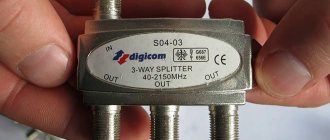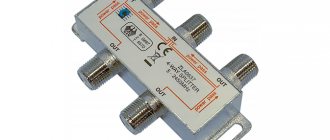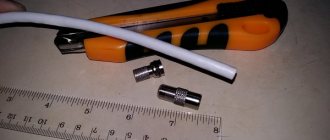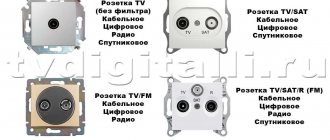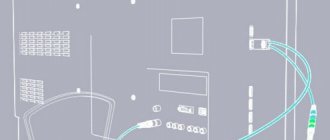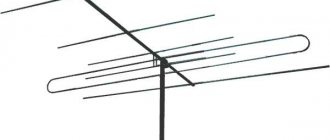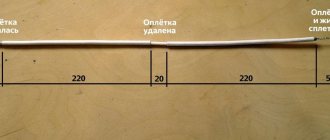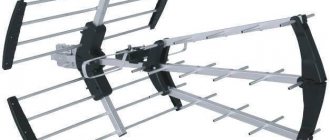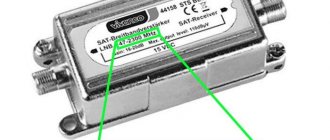A TV splitter is a special antenna divider. They are used in cases where there is more than one TV in the room and the signal needs to be distributed consistently between different consumers. A television splitter with an amplifier can serve a large number of devices at once (from 3 and above).
And if we talk about such devices, in general, they are necessary for frequency separation of channels. And also such devices additionally have built-in protection against incorrect pulse voltages and currents that may arise in the cable cores during a thunderstorm. The splitter also protects against interference from power transmission lines and contact networks of electric vehicles.
Possibility of connecting more than one TV to the antenna
When connecting two TVs with T2 tuners to the antenna to watch digital television, you need to be prepared for a loss of image quality. A good signal is divided into two equal parts and in this form is sent to both devices . And if 3 TVs are connected, then only a third of the original signal remains for each of them.
Important! Another factor that will affect the final picture on the screen is the length of the cable. The larger it is, the worse the image will be. Therefore, you should make sure that the distance from the TV to the splitter is small.
All this indicates that using one antenna to watch digital TV channels on a pair of devices is only relevant in cases where the signal is initially very good, and its division into two parts will not cause significant image deterioration. Indoor antennas are not suitable for signal multiplication. Several TVs can only be connected to an outdoor antenna (Meridian and others), cable or satellite television (Tricolor, etc.).
Connection method
Manufacturers of splitters, dividers and adders make sure that the device can be installed or dismantled quickly and efficiently. For this purpose, the crab ports are equipped with F connectors with external threads.
Cable ends ready for connection
The connection is made as follows:
- The ends of the cables are stripped so that the bare core protrudes from the sheath by 1.5-2 cm.
- Slightly stepping back from the edge of the cut core insulation, peel off the surface coating to expose a 1.5 cm long braid.
- The braid is wrapped around the insulation.
- The end is inserted into the counter F connector so that the connection is sufficiently tight.
- The connector nut with internal thread is screwed onto the desired splitter port.
F connectors
Old-style utility TV signal routers require soldering of stripped cable ends or have special clamping brackets.
How to connect two TVs to an antenna
To split the signal into two television panels, you will need a splitter, five F-connectors, 2 television plugs and a cable. In this case, a splitter for connection should be purchased with two outputs. If there are three of them, and one is unoccupied, then it will be necessary to connect a ballast resistor with a resistance of 75 Ohms to it.
Advice! If you plan to connect several more TVs in the future, you can immediately purchase a splitter for the required number of devices and plug the free outputs with ballast resistors.
The connection procedure consists of the following sequence of actions.
- First you need to position the splitter correctly - it should be located a short distance from each of the TVs, and the cable should fit freely to it.
- After the antenna splitter is secured in its new location, you need to prepare the cable. To do this, cut it to the required length, trim the edge and wrap the braid. The central core should protrude by about 5 mm, its insulator should also protrude, but a little less. Then you need to screw the F-connector onto the cable on top of the wrapped braid.
- Next, you should cut two pieces of cable that will be pulled to the TVs and prepare them in the same way on both sides. Then you need to put on the F-connectors and a plug on each of the wires.
- Next, you need to connect the antenna cable to the splitter, then the cut pieces, then stretch their other ends to the TVs and connect.
- Then you need to turn on the television panels and check their operation. If all steps are performed correctly, a good image will appear on each device.
Selecting a TV cable
In technical documentation, a television cable is called coaxial, that is, a coaxial structure. The central core and braid along the entire length of the communication ensure transmission across the entire cross-sectional width in one direction.
A TV cable is characterized by the presence of four characteristics:
- The main core is made of copper.
- Core covered with foamed polyethylene.
- Screen made of twisted tape, foil or aluminum wire braid.
- The outer shell is made of PVC.
Note! A good antenna cable differs in the metal of the core, the composition and density of the screen, and the type of outer coating. High-quality products are characterized by the presence of a copper core, aluminum wire braid and a rubberized sheath.
Features of connecting three or more TVs
When connecting three or more TVs to one antenna, you need to take into account that the signal in this case will reach the devices very weakly. This means that you can count on showing only analog channels; digital broadcasts are possible only with a very good source signal.
Advice! To get a good result when connecting three or more TV receivers to one antenna, you need to use only a high-quality cable with a resistance of 75 Ohms and a frequency range of up to 1000 MHz.
But recently, all sorts of amplifiers have come on sale, which (as the manufacturers claim) are capable of multiplying the signal from one antenna to several TVs without loss of quality.
The diagrams for connecting two (a) and three (b) TV receivers to one antenna look like this:
What is an antenna divider?
As the name suggests, an antenna splitter is a device consisting of a compact metal housing with several cable connectors, which serves to distribute the signal to several receivers. Not all splitters perform the same function, so they are grouped together.
Dividers (splitters)
TV cable dividers
The TV signal is evenly distributed to the required number of outputs. Indispensable in home cabling. The most popular type of television accessories among consumers. The main dividers that can be found in stores.
- From 5 to 1000 MHz – used for analogue cable and terrestrial digital television.
- From 5 to 2400 MHz (with power pass) – used mainly for satellite TV.
Couplers
Coupler (TAR)
Sometimes the signal needs to be divided so that the main part of it is sent to one output (OUT), and the small remaining part is sent to a tap (TAP), where the signal will be much weaker than at the main output, where the main part goes. In the future, the same coupler can be connected to this main output, and the signal quality will not be lost. This type of divider is used in daily practice by cable TV providers when installing multi-apartment television networks. A band blocker or cable plug, a type of tap, works on the same principle, which can be useful when separating free and paid channels.
Adders (diplexers)
Adder (diplexor)
Of practical interest is an antenna divider capable of conducting a signal in the opposite direction and thus summing it. Combiners are able to mix signals from several wave receivers with different frequency characteristics into one cable. That is, you can sum up satellite and cable or digital television.
You may be interested in: Connect a monitor to a digital TV set-top box
Signal Boost
As mentioned above, the signal can be amplified using special devices. To improve an initially weak signal, the user will need a special amplifier that is mounted near the antenna, and if the signal is good, but it is only enough for one TV, you should use an active antenna splitter . Read more about these devices and the features of their connection later in the material.
Antenna with amplifier
An active antenna with amplifier requires mains power. If you use an outdoor antenna, finding an outlet nearby is problematic. In this situation, there are two ways to provide power to the device.
The first option allows you to supply voltage to the antenna directly from the TV through a cable transmitting the TV signal. This is possible using a special splitter that allows the passage of power supply, which can be identified by the Power Pass inscription near one of the outputs. A cable going to one of the TV receivers is connected to this connector, with the power supply at the other end connected to the socket.
Advice! Splitters with power supply are convenient when using DVB-T2 set-top boxes. In this case, power is supplied through the tuner, eliminating the need for another power supply.
The second method is relevant if such a splitter is not available (since it is a rather scarce product). In this case, you can provide power supply using a special adapter. On one side it has an antenna socket into which you need to insert a separator from the power supply. On the other side there is an internal thread and a needle, which must be screwed onto the input of the divider. After connecting the unit to the mains, power will flow even through a conventional divider.
It is better to take a power supply for the amplifier with voltage regulation in order to increase or decrease it if necessary. This may be relevant if the signal is amplified. In this case, when watching digital television, the video may freeze until the voltage is reduced.
Splitter with amplifier
If the antenna signal is good, but it is not enough for several TVs, you can use a special active splitter. It looks like a regular splitter, but inside it is a chip and resistors. When connecting a couple of television panels, you can try to do without it, but if the signal is divided into three or more parts, it must be used .
Power for the active splitter is supplied in the same way as for the antenna with amplifier. The cable going to the TV is connected to the output labeled “Power Pass”, with the power supply connected on the other side (first method).
Connecting antenna splitters
Considering the type of product, there are several ways to connect the splitter. Devices equipped with a screw-type clamp do not require soldering and can be connected to cables of various diameters. Products with a threaded connection are suitable only for wires with a small diameter, but soldering is also not required. Devices with coaxial sockets are considered universal; standard antenna connectors are used for cable installation. For some types of splitters, connection is provided exclusively by soldering. The method for connecting the device is as follows:
- First you need to find a suitable surface for mounting the device.
- You will need to remove the plugs from each splitter connector.
- Next, connect the input to the TV receiver and the socket using a coaxial cable.
- After this, you can connect the common television wire.
The connection process takes about 15-20 minutes. If, after installing a splitter, the picture quality on several TVs decreases, it is recommended to use a more powerful active type antenna. You can also try buying a splitter with an amplifier. In some cases, distortion occurs when the signal level is too high.
Features of connecting to a satellite dish
You can connect a satellite dish to two TVs using several receivers or through a high-frequency modulator.
Via RF modulator
If the satellite dish is equipped with a high-frequency modulator, you can connect a regular splitter to its output, and from there run a cable to the television panels. In this case, when you switch the channel on the receiver, it will simultaneously change on both TV receivers.
Advice! This inconvenience can be partially avoided by connecting one or both TVs to the receiver via RCA or SCARD. In this case, in addition to the satellite antenna, it will be possible to connect an outdoor or indoor antenna to the device, which will allow you to configure the display of regular over-the-air channels.
Through additional receivers
If you have not 1 receiver, but two, you can use them to configure the display of satellite channels on different television panels. There are four ways to do this.
- The first method is a serial connection. If one of the receivers has not only an antenna input, but also an output, you need to connect a converter to it, from which you run a special certified cable suitable for satellite equipment to the second receiver. The disadvantages of this method are that to watch encrypted channels you will need two cards, which implies a double subscription fee. Also, with this connection, it is impossible to simultaneously watch channels with different polarization (horizontal and vertical) on two TVs.
- The second method is to use a special certified splitter (a standard splitter is not suitable due to the difference in voltage required to power the converter and switch polarization). The head for the satellite dish (converter) is connected to it, and cables go from it to the TVs. The disadvantages of this connection are the same as in the previous method. This connection should only be used if none of the receivers have an antenna output.
- Another way is to purchase and install a second converter. This will allow you to use two receivers independently of each other, but you will need to point them to different satellites, which means you will have to watch different channels. Each person will need their own card with a separate subscription fee.
- And the last connection method is to use a receiver with two outputs for horizontal and vertical polarization. The cable from them needs to be connected to the multiswitch. And from this device you can connect up to three television panels. Then on all TV receivers you can independently watch channels in different polarizations, the multiswitch will independently make all the necessary conversions. However, cards must be purchased according to the number of receivers, and the subscription fee will also be paid according to the number of connected devices.
In conclusion, it should be noted that there are usually no difficulties in connecting several TVs to one antenna. This is a fairly easy process if you know the connection diagram and the correct sequence of actions. It is worth remembering that the antenna signal is divided into several parts, and if it is enough to receive analog channels, then digital television may ultimately not work.
How do dividers work?
There are times when they try to connect two cables in parallel directly to the antenna in order to connect 2 TVs. In principle, this is possible, but it will not be possible to obtain the desired result. The fact is that any wired product has its own characteristic impedance. At the cable design stage, technologists lay down characteristics that ensure equal wave impedances of 1 cable and 1 TV.
When several TV signal conductors are directly connected to the antenna, the TVs will not broadcast anything. To prevent this from happening, coaxial cable splitters (dividers) with calculated characteristic impedance are used. Splitters divide the signal into equal parts, equalizing the impedance levels with that of the signal source.
The best TVs of 2018
TV LG 43UK6200 on Yandex Market
Sony KD-55XF9005 TV on Yandex Market
When a second television panel appears in the house, the question arises - how to connect two televisions to one antenna. This is quite easy to do. If necessary, you can connect not two, but three or even 4 TVs to a regular antenna, cable television or satellite dish. You just need to know how to do this correctly, and take into account that when the signal is divided into several equal parts, its quality deteriorates.
Types of devices
Antenna television signal dividers come in different types , but they all perform the same task. The input connector, designated in Latin letters IN, is intended for connecting a television cable, through which a signal is transmitted either from an external antenna installed on the roof of a high-rise building, or from a cable of a cable television system laid in the house. Other connectors of this device are designated by the Latin letters OUT. You need to connect the antenna cables of all TVs in the apartment to them.
Which TV splitter is better? When purchasing a TV splitter, you must take into account the total number of television receivers with which this device will work. If in the future the number of consumers may increase, this must be taken into account in order to choose a TV splitter, which is also called a crab, with a reserve number of outputs. An antenna splitter for two TVs is currently in greatest demand among buyers.
If it is necessary to organize a television network in an apartment building, taps (TAP) are used. They differ from TV splitters by the presence of a pass-through connector .
A cable connected to this connector can connect it to the input of the next tap. So a television signal from one source can be distributed among a large number of consumers.
Possibility of connecting more than one TV to the antenna
When connecting two TVs with T2 tuners to the antenna to watch digital television, you need to be prepared for a loss of image quality. A good signal is divided into two equal parts and in this form is sent to both devices . And if 3 TVs are connected, then only a third of the original signal remains for each of them.
Important! Another factor that will affect the final picture on the screen is the length of the cable. The larger it is, the worse the image will be. Therefore, you should make sure that the distance from the TV to the splitter is small.
All this indicates that using one antenna to watch digital TV channels on a pair of devices is only relevant in cases where the signal is initially very good, and its division into two parts will not cause significant image deterioration. Indoor antennas are not suitable for signal multiplication. Several TVs can only be connected to an outdoor antenna (Meridian and others), cable or satellite television (Tricolor, etc.).
Characteristics of splitters
These include:
- throughput;
- attenuation level;
- presence of an amplifier.
Bandwidth
On the splitter body, the manufacturer indicates the frequency range of the device’s throughput. The universal satellite splitter, which perceives a frequency band from 5 to 2500 MHz, has good qualities. This makes it possible to simultaneously combine satellite and terrestrial TV signals.
Attenuation level
What matters is the level of attenuation. The smaller it is, the less noticeable the loss in video picture and sound quality will be. This parameter is often determined by eye. If signal attenuation is clearly visible on the screen (loss of image quality, sound distortion), then signal amplification will be required.
Availability of amplifier
When choosing a splitter, you need to determine the need for a built-in amplifier. It may be needed when connecting four or more TVs. The high-frequency amplifier requires power from the electrical network. This circumstance must be taken into account, since it is necessary that the power cord of the device does not create inconvenience during installation.
How to connect two TVs to an antenna
To split the signal into two television panels, you will need a splitter, five F-connectors, 2 television plugs and a cable. In this case, a splitter for connection should be purchased with two outputs. If there are three of them, and one is unoccupied, then it will be necessary to connect a ballast resistor with a resistance of 75 Ohms to it.
Advice! If you plan to connect several more TVs in the future, you can immediately purchase a splitter for the required number of devices and plug the free outputs with ballast resistors.
The connection procedure consists of the following sequence of actions.
- First you need to position the splitter correctly - it should be located a short distance from each of the TVs, and the cable should fit freely to it.
- After the antenna splitter is secured in its new location, you need to prepare the cable. To do this, cut it to the required length, trim the edge and wrap the braid. The central core should protrude by about 5 mm, its insulator should also protrude, but a little less. Then you need to screw the F-connector onto the cable on top of the wrapped braid.
- Next, you should cut two pieces of cable that will be pulled to the TVs and prepare them in the same way on both sides. Then you need to put on the F-connectors and a plug on each of the wires.
- Next, you need to connect the antenna cable to the splitter, then the cut pieces, then stretch their other ends to the TVs and connect.
- Then you need to turn on the television panels and check their operation. If all steps are performed correctly, a good image will appear on each device.
Features of connecting three or more TVs
When connecting three or more TVs to one antenna, you need to take into account that the signal in this case will reach the devices very weakly. This means that you can count on showing only analog channels; digital broadcasts are possible only with a very good source signal.
Advice! To get a good result when connecting three or more TV receivers to one antenna, you need to use only a high-quality cable with a resistance of 75 Ohms and a frequency range of up to 1000 MHz.
But recently, all sorts of amplifiers have come on sale, which (as the manufacturers claim) are capable of multiplying the signal from one antenna to several TVs without loss of quality.
The diagrams for connecting two (a) and three (b) TV receivers to one antenna look like this:
Safety precautions
If the owners need to leave their home for a certain period of time, then measures should be taken to ensure the safe storage of television equipment. To avoid the risk of lightning and static discharges entering the electrical circuit for supplying TV signals, you need to disconnect the receiver, antenna amplifier, splitter with a built-in amplifier, and televisions from the power supply.
The correct choice of crab for the antenna, brand of cable, and their high-quality connection will be the key to high-quality viewing of TV programs. If you encounter difficulties in installing TV signal routers yourself, it is better to contact specialists. They will select communication devices and install them quickly.
Signal Boost
As mentioned above, the signal can be amplified using special devices. To improve an initially weak signal, the user will need a special amplifier that is mounted near the antenna, and if the signal is good, but it is only enough for one TV, you should use an active antenna splitter . Read more about these devices and the features of their connection later in the material.
Antenna with amplifier
An active antenna with amplifier requires mains power. If you use an outdoor antenna, finding an outlet nearby is problematic. In this situation, there are two ways to provide power to the device.
The first option allows you to supply voltage to the antenna directly from the TV through a cable transmitting the TV signal. This is possible using a special splitter that allows the passage of power supply, which can be identified by the Power Pass inscription near one of the outputs. A cable going to one of the TV receivers is connected to this connector, with the power supply at the other end connected to the socket.
Advice! Splitters with power supply are convenient when using DVB-T2 set-top boxes. In this case, power is supplied through the tuner, eliminating the need for another power supply.
The second method is relevant if such a splitter is not available (since it is a rather scarce product). In this case, you can provide power supply using a special adapter. On one side it has an antenna socket into which you need to insert a separator from the power supply. On the other side there is an internal thread and a needle, which must be screwed onto the input of the divider. After connecting the unit to the mains, power will flow even through a conventional divider.
It is better to take a power supply for the amplifier with voltage regulation in order to increase or decrease it if necessary. This may be relevant if the signal is amplified. In this case, when watching digital television, the video may freeze until the voltage is reduced.
Splitter with amplifier
If the antenna signal is good, but it is not enough for several TVs, you can use a special active splitter. It looks like a regular splitter, but inside it is a chip and resistors. When connecting a couple of television panels, you can try to do without it, but if the signal is divided into three or more parts, it must be used .
Power for the active splitter is supplied in the same way as for the antenna with amplifier. The cable going to the TV is connected to the output labeled “Power Pass”, with the power supply connected on the other side (first method).
Features of connecting to a satellite dish
You can connect a satellite dish to two TVs using several receivers or through a high-frequency modulator.
Via RF modulator
If the satellite dish is equipped with a high-frequency modulator, you can connect a regular splitter to its output, and from there run a cable to the television panels. In this case, when you switch the channel on the receiver, it will simultaneously change on both TV receivers.
Advice! This inconvenience can be partially avoided by connecting one or both TVs to the receiver via RCA or SCARD. In this case, in addition to the satellite antenna, it will be possible to connect an outdoor or indoor antenna to the device, which will allow you to configure the display of regular over-the-air channels.
Through additional receivers
If you have not 1 receiver, but two, you can use them to configure the display of satellite channels on different television panels. There are four ways to do this.
- The first method is a serial connection. If one of the receivers has not only an antenna input, but also an output, you need to connect a converter to it, from which you run a special certified cable suitable for satellite equipment to the second receiver. The disadvantages of this method are that to watch encrypted channels you will need two cards, which implies a double subscription fee. Also, with this connection, it is impossible to simultaneously watch channels with different polarization (horizontal and vertical) on two TVs.
- The second method is to use a special certified splitter (a standard splitter is not suitable due to the difference in voltage required to power the converter and switch polarization). The head for the satellite dish (converter) is connected to it, and cables go from it to the TVs. The disadvantages of this connection are the same as in the previous method. This connection should only be used if none of the receivers have an antenna output.
- Another way is to purchase and install a second converter. This will allow you to use two receivers independently of each other, but you will need to point them to different satellites, which means you will have to watch different channels. Each person will need their own card with a separate subscription fee.
- And the last connection method is to use a receiver with two outputs for horizontal and vertical polarization. The cable from them needs to be connected to the multiswitch. And from this device you can connect up to three television panels. Then on all TV receivers you can independently watch channels in different polarizations, the multiswitch will independently make all the necessary conversions. However, cards must be purchased according to the number of receivers, and the subscription fee will also be paid according to the number of connected devices.
In conclusion, it should be noted that there are usually no difficulties in connecting several TVs to one antenna. This is a fairly easy process if you know the connection diagram and the correct sequence of actions. It is worth remembering that the antenna signal is divided into several parts, and if it is enough to receive analog channels, then digital television may ultimately not work.
How the satellite system works
The satellite television system consists of several devices, these are:
- Antenna dish;
- Receiver (tuner);
- Lightning protection;
- TV cable;
- Splitter (divider).
Antenna dish
The receiving device looks like a concave metal disk that is mounted on the wall or roof of the house. The satellite antenna is oriented towards the satellite orbit. There are mobile models that are equipped with an electric motor and can be turned in any direction at the request of the owner.
Receiver
The tuner, or receiver, is the main part of satellite equipment. Its functions include signal amplification, tuning to a specific frequency, and filtering interference. The tuner displays the settings menu on the TV screen. Using the remote control, you control the receiver, selecting your preferred channel with different adjustment levels.
Lightning protection
Manufacturers install lightning protection elements on the amplifier board in the form of two glass diodes. The protection is designed to localize static discharges that occur during a thunderstorm. This device will not save you from destruction from a direct lightning strike on the plate.
Protection in the form of a barrel with F connectors is built into the TV cable. It takes on a powerful thunderstorm impulse. The part burns out, but does not allow the destructive energy flow to penetrate into the receiver and TV.
TV cable
A television cable is a transmitter of a TV signal between satellite, terrestrial and wired television segments. The main core is enclosed in a dense vinyl sheath, on top of which there is shielding in the form of a braided braid made of thin aluminum wire. In turn, the top of the antenna cable is covered with plastic insulation.
Splitter (divider)
The device distributes a signal to several television receivers. It is built into the cable between the tuner and TVs.
Prime divisor
Purpose and main differences
Splitters allow you to evenly divide a television signal between several outputs. For example, if the input signal level was 12 dB, then at the outputs of a double divider it will be 6 dB, a triple divider - 4 dB, and a quad divider - 3 dB.
Double splitter
The figure shows a schematic representation of a double splitter, where:
A – signal input;
Antenna splitters of this type are used in cases where it is necessary to send a signal to 2 or 3 TVs, or more if the device has an amplifier (active splitter). An example is the model of the Polish manufacturer ARA-01A.
Diplexers allow you to combine two signals into one. Most adder models are universal; they can work in two directions, that is, act as an adder or a divider.
Dual diplexer
The figure shows a schematic representation of a double diplexer, where:
A and B – input signals;
C – output signal.
A diplexer is used in cases where it is necessary to run a signal from a satellite and a conventional antenna over one cable or combine signals from different ranges. The figure shows an example of using an adder and a divider together, where:
- A – television antenna;
- B – satellite dish;
- C – adder;
- D – socket with a built-in divider for connecting two television cables.
Scheme of joint use of an adder and a divider
Tappers are used to organize a backbone television network, for example, to divert a signal to apartments in a multi-storey building.
Highway organization diagram
The figure shows an example of organizing a highway using several taps, where:
- A – incoming signal;
- B, C, D, E, F, G, H, I, J – signal output (tap), for example, to each floor of a nine-story building.
As can be seen from the connection diagram, such devices have one pass-through output, from which the signal is supplied to the input connector of the next coupler.
Video: TV antenna splitter.
Antenna splitters can also include a range blocker (stub), which is widely used by cable television operators to separate social and paid connection packages.
In everyday life, splitters are most often used; they are used to connect several televisions to the antenna cable entering the apartment; the quality of the television signal directly depends on these devices.
Difference between splitter, combiner and splitter
Setting up an MTS satellite dish
A splitter is a device that divides the signal between outputs in equal shares. The coupler has an uneven signal output level. Much lower power transmission will come from the tap than will occur from the output connector. Such devices are used to distribute TV signals in multi-storey buildings.
For example, a tap is connected to the floor wiring, and the signal coming from the output will be transmitted to the next levels of the building. Thus, it is possible to connect numerous consumers without losing the quality of the received television signal.
Adders combine incoming pulses from different receiving devices so that the subscriber can alternately view programs from a satellite, cable or terrestrial antenna.
How to choose
First of all, it should be taken into account that the operating frequency of antenna splitters for digital television and satellite dishes is different. For the former it is limited to 1 GHz, for the latter it is 2.5 GHz. In addition, the satellite splitter may have a “Powerpass” function (allows you to supply power to the satellite dish head).
Note that a satellite splitter can also be used to split a digital or analog signal.
The second parameter that you should pay attention to is signal attenuation; as a rule, its value is indicated on the device body; the lower it is, the lower the losses.
It is also important who the manufacturer of the device is. Products from such well-known manufacturers as: Lans, Rexant, Premier, TAH, Luxmann, Alda, Hama, Sat, etc. will give an output signal an order of magnitude better than Chinese or homemade splitters.
How to connect
The instructions for connecting the splitter are quite simple:
- select a location and attach the divider to it;
- Next, you need to remove the plug from the antenna splitter (do this operation for each connector);
- use a coaxial cable (adapter) to connect the input to the TV and the jack;
- connect the television cable entering the apartment.
At this point the installation can be considered complete; installation takes no more than 10 minutes.
Crab mounting options for TV antenna
Depending on the conditions and requirements for the interior of the room, installation options for the crab can be as follows:
- If the television cable is laid in the wall, then at the place where the splitter is inserted, the groove is opened and expanded to the required size. When restoring the finishing coating, it is better to close the opening with a decorative cover. You can quickly and easily replace a device or connect an additional channel;
- External wiring with a divider is done in non-residential rooms. Where it is impossible to spoil the interior of the office space, cables and dividers are hidden in plastic boxes;
- For floor wiring, the cable and splitters are placed in special channels inside the baseboards.
Do it yourself
It’s not difficult to make a splitter for analog television with your own hands; here are some simple diagrams of such a device.
Passive splitter with resistors.
Separator circuit for two and three devices
The figure shows two diagrams:
- a – for connecting two TVs (R1, R2, R3 = 25 Ohm);
- b – for connecting three TVs (R1, R2, R3, R4 = 36 Ohm).
Below is an example of a printed circuit board layout for circuit “b”.
Splitter board for three devices
The assembled device must be placed in a special case (any metal box will do for this), which should preferably be grounded. If the grounding is incorrect, interference in the form of snow may occur. Actually, it is better not to ground at all than to do it incorrectly.
If the image on the TV screen is double, you should put a ferrite ring on the coaxial cable between the splitter and the TV.
Active splitter circuit.
In cases where you have a low level of the incoming television signal, you can correct the situation using a divider that has a broadband frequency amplifier. The diagram of such a device is shown in the figure below.
Divider circuit with antenna amplifier
Parameters of the elements indicated in the diagram:
- R1-10 Ohm;
- R2, R4, R5 – 430 Ohm;
- R3 – 30 kOhm;
- R6 – 150 Ohm;
- R7 – 470 Ohm;
- R8-R10 – 43 Ohm;
- C1, C2, C4 – 150 pF;
- C3 – 0.01 µF;
- VT1 – VT2 – KT399A;
Choke L1 is a frameless coil wound with PEV-2 wire with a cross-section of 0.4 mm, the diameter of the coil is five millimeters, there are 4 or 5 turns.
You can use batteries to power the circuit, but it is better to take a power supply for this. In the latter case, the transformer may create interference, so it is advisable to place the power supply in a separate housing. That is why it is advisable to install the splitter in a wireless zone, that is, where there is no electrical wiring.
Note that the above antenna splitter circuits have proven themselves to be effective in dividing analog signals; as for satellite and digital television, it is better for them to buy a ready-made device than to make it yourself.
Price overview
As an example, we chose the Luxmann SP-202 splitter, which allows you to connect two TVs to one antenna cable.
| City | Cost (USD) | City | Cost (USD) |
| Ekaterinburg | 4 | Penza | 4,2 |
| Krasnoyarsk | 4,1 | Minsk | 4,1 |
| Moscow | 3,8 | SPb (Petersburg) | 3,85 |
As can be seen from the table, the price of an antenna splitter in Moscow, Krasnoyarsk, Minsk and other cities does not vary much. How economically profitable it is to make it yourself or buy it is up to you to decide.
